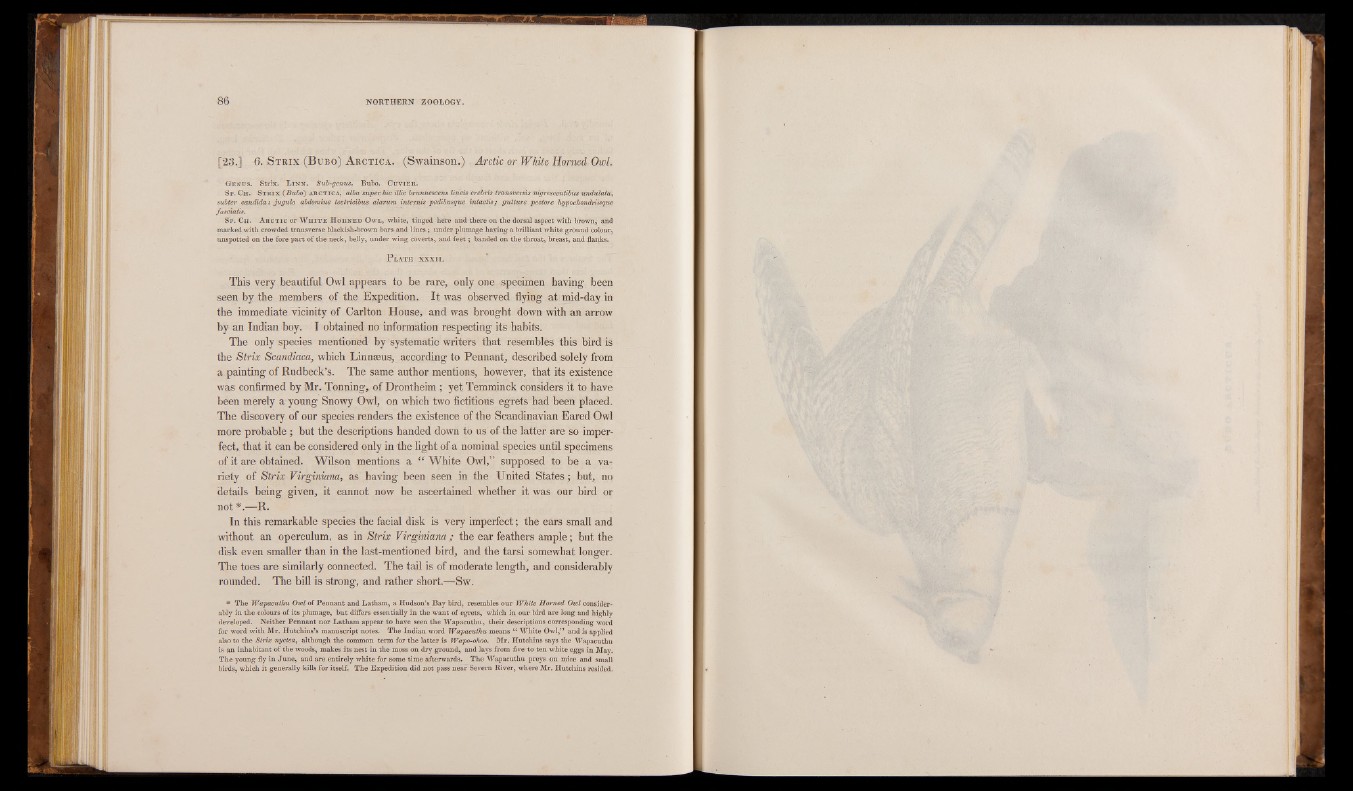
86 NORTHERN ZOOLOGY.
[23.] 6. Strix (Bubo) Arctica. (Swainson.) . Arctic or White Homed Owl.
Ge n u s . Strix. L in n . Sub-genus. Bubo. Cu v ie r .
Sp . C h . St r ix (Bubo) a r c t ic a , alba super hie illic brunnescens lineis crebris Iransversis nigrescentibus undulata,
suiter Candida: jugulo abdomine tectricibus alarum intemis pedibusque intactis; gutture pec tore hypochondriisque
fasciatis.
Sp . Ch . A r c t ic or W h it e H o r n e d Ow l, w hite, tinged here and there on the dorsal aspect w ith brown, and
marked w ith crowded transverse blackish-brown bars and lines; under plumage having a brilliant white ground colour,
unspotted on the fore part of the neck, belly, under wing coverts, and fe e t; banded on the throat, breast, and flanks.
P late x x x ii.
This very beautiful Owl appears to be rare, only one specimen having been
seen by the members of the Expedition. It was observed flying at mid-day in
the immediate vicinity of Carlton House, and was brought down with an arrow
by an Indian boy. I obtained no information respecting its habits.
The only species mentioned by systematic writers that resembles this bird is
the Strix Scandiaca, which Linnaeus, according to Pennant, described solely from
a painting of Rudbeck’s. The same author mentions, however, that its existence
was confirmed by Mr. Tonning, of Drontheim; yet Temminck considers it to have
been merely a young Snowy Owl, on which two fictitious egrets had been placed.
The discovery of our species renders the existence of the Scandinavian Eared Owl
more probable; but the descriptions handed down to us of the latter are so imperfect,
that it can be considered only in the light of a nominal species until specimens
of it are obtained. Wilson mentions a “ White Owl,” supposed to be a variety
of Strix Virginiana, as having been seen in the United States; but, no
details being given, it cannot now be ascertained whether it was our bird or
not *.-^R.
In this remarkable species the facial disk is very imperfect; the ears small and
without an operculum, as in Strix Virginiana ; the ear feathers ample; but the
disk even smaller than in the last-mentioned bird, and the tarsi somewhat longer.
The toes are similarly connected. The tail is of moderate length, and considerably
rounded. The bill is strong, and rather short.—Sw.
* The Wapacuthu Owl of Pennant and Latham, a Hudson’s Bay bird, resembles our White Horned Owl considerably
in the colours of its plumage, but differs essentially in the want of egrets, which in our bird are long and highly
developed. Neither Pennant nor Latham appear to have seen the Wapacuthu, their descriptions corresponding word
for word with Mr. Hutchins’s manuscript notes. The Indian word Wapacuthu means “ White Owl,” and is applied
also to the Strix nyctea, although the common term for the latter is Wapo-ohoo. Mr. Hutchins says the Wapacuthu
is an inhabitant of the woods, makes its nest in the moss on dry ground, and lays from five to ten white eggs in May.
The young fly in June, and are entirely white for some time afterwards. The Wapacuthu preys on mice and small
birds, which it generally kills for itself. The Expedition did not pass near Severn River, where Mr. Hutchins resided.